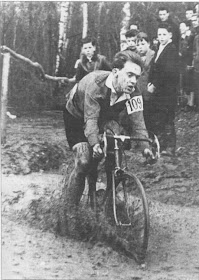Kids these days with their video games and camera phones,
backwards hats and baggy pants.
They are even riding fat tire road bikes now! Back in my day we sent telegrams and took Daguerreotypes,
and all of our road bikes had 21c tires.
We certainly didn’t ride them off road, let alone with beer hand-ups,
dollar grabs, and cowbells. What
is this cyclocross all the kids are doing these days? And why do their brakes never work well?
Let’s face it.
Cyclocross is blowing up, nay, has already blown completely and is now
expanding like the post big bang universe in which we ride. People everywhere are adopting wide knobby
tires and complaining about their brakes.
Racing drop-bar bikes on the grass and mud in the mucky mid-Atlantic
autumn is a lesson in toughness. Cyclocross
is far from an American phenomenon, though. Like almost everything cycling related, its roots lie in
Europe.
As you might expect, the acute origin of cyclocross is much
debated. I think it is safe to say
that the sport evolved out of off-season training rides in the northern
European countries (mainly France and Belgium). Riders, in preparation for the coming road season, would
brave the harsh elements of winter and resort to off-road riding to avoid
disastrous road conditions. Running
up impassable sections would warm the feet and toes, while also providing a
more complete workout. Handling
skills were honed. Muscles were
honed. Men were made tough.
Interestingly enough, the first sanctioned cyclocross races
took place in France in 1902—even before the Tour de France—although at this
point in history, road cycling was already much larger than cyclocross. Racing grew organically until 1910 when
Octave Lapize attributed his Tour de France win that year to off-season
cyclocross training. The sport
quickly became international.
In 1924 France hosted the first international competitions
in Paris, and in 1950 UCI sanctioned the first cyclocross World
Championships.
The first dominant force in the sport came in the late sixties
in the form of a man named de Vlaeminck—but not the de Vlaeminck you already
know. Eric de Vlaeminck, Roger’s
brother, won 7 cyclocross world championships—six in a row from 1968-1973. Even “The Badger” himself, Bernard
Hinault, was a prominent racer in cyclocross in the mid-80s, though he is
better known for winning the Tour 5 times.
Storied past aside though, what has made ‘cross become so
big in the US recently? That, I believe, has much more to do with the culture
that surrounds ‘cross, in addition to the race itself. Much like mountain biking, cyclocross
boasts an atmosphere centered on inclusion, drinking beer, and suffering—which
for roadies who disdain the seriousness and occasional douchbaggery that haunts
road riding, can be a welcome change.
Plus who doesn’t like playing in the mud?
 |
| Ben Berden gets dirty |
Cyclocross’s rapid ascension in the United States may also
be due to the fact that we are simply SO far behind Europeans in this
sport. In the entire history of
the Cyclocross World Championships an American has only graced the podium
once. A feat, which will surely be
improved upon soon—or at least, we all hope, as 2013’s edition of Worlds will
be held on American soil in Louisville.
Recently the sport has been utterly dominated by Belgians, with many races
becoming only a question of how many Belgians will finish before the next
country breaks up the train of light blue, black, yellow, and red.
 |
| Sven Nys, one of the most dominant Belgians of the last 10 years |
Recent Belgian dominance is actually quite astonishing. Since 2002, the Belgians have swept the
podium at Worlds a remarkable FIVE times—winning no less than 25 medals (8
gold) during that period.
You shouldn’t have to worry about being lapped by a flying
Belgian in your local races though, just expect good times and hard
riding. The Mid-Atlantic region
touts one of the most robust cyclocross race schedules in the country. You can surely fill most all of your
weekends from now until the end of the season if you so desire. Check out the MAC series if you are
looking for some really well run introductions to ‘cross racing and
culture.
That is maybe the best part of the whole equation: Cyclocross is not about
intimidation. It’s about just
jumping in, giving it a go—and maybe drinking a beer on the way.
Speaking of “jumping in,” I will leave you with what might
be the greatest 18 seconds of cyclocross footage ever recorded. Don’t worry though; Joey is okay.








No comments:
Post a Comment